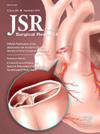脊柱枪伤后的抗生素预防和脊柱感染:回顾性研究。
IF 1.8
3区 医学
Q2 SURGERY
引用次数: 0
摘要
简介:脊柱和脊柱旁感染(SPI)是脊柱外伤后的一种潜在并发症,我们试图确定脊柱枪伤(GSW)后抗生素预防与SPI发生的关系:单中心回顾性队列研究的对象是脊柱枪伤超过 11 年的成年人。研究对抗生素的使用和损伤模式进行了分析:共有330名患者纳入分析。大多数患者为男性(88%)、黑人(79%),平均年龄为 27 岁。死亡率为 4%。65%的患者使用了预防性抗生素,中位持续时间为5天。中空内脏损伤(HVIs)(66.7% 对 23.1%,P < 0.001),主要是结肠损伤(55.6% 对 12.5%,P < 0.001),与 SPI 独立相关。抗生素的使用与 SPI 的降低无关(3% 对 2%;P = 0.41)。在出现 SPI 的患者中,有 7 名患者接受了 3 天或更短时间的抗生素治疗,但这并无统计学意义(P = 0.49):结论:脊柱GSW术后,HVI患者的SPI发生率较高。尽管抗生素的使用和持续时间与SPI没有统计学意义,但即使是HVI患者,使用4天或4天以上抗生素的患者也没有发生感染。由于 SPI 发生率较低,多中心试验可能有助于确定预防性抗生素的最佳持续时间。不过,我们建议在 GSW 后最多使用 4 天抗生素预防 SPI。本文章由计算机程序翻译,如有差异,请以英文原文为准。
Antibiotic Prophylaxis and Spinal Infection After Gunshot Wounds to the Spine: A Retrospective Study
Introduction
Spinal and paraspinal infections (SPIs) are a potential complication following traumatic spinal column injury, and we sought to determine the association of antibiotic prophylaxis on SPI development following a spinal gunshot wound (GSW).
Methods
A single-center retrospective cohort study was performed on adults who sustained a GSW to the spinal column over 11 y. Patients were excluded if they died within 24 h or had a mechanism other than GSW. Antibiotic use and injury patterns were analyzed.
Results
A total of 330 patients were included in analysis. Most were male (88%), Black (79%), and averaged 27 y old. Mortality was 4%. Prophylactic antibiotics were administered in 65%; and median duration was 5 d. Nine patients (2.7%) developed SPI. Hollow viscus injury (HVIs) (66.7% versus 23.1%, P < 0.001), primarily colon injuries (55.6% versus 12.5%, P < 0.001), were independently associated with SPI. Antibiotic use was not associated with a decrease in SPI (3% versus 2%; P = 0.41). Of the patients who developed SPI, seven received 3 d of antibiotics or less, and this was not statistically significant (P = 0.49).
Conclusions
Patients with HVIs have a higher incidence of SPI, following spinal GSW. Although antibiotic use and duration did not have a statistically significant association with SPI, no patient, even with HVIs, who received 4 or more days of antibiotics developed an infection. Due to the low incidence of SPI, a multicenter trial may help determine the optimal duration of prophylactic antibiotics. However, we recommend a maximum of 4 d of antibiotics for SPI prophylaxis following GSW.
求助全文
通过发布文献求助,成功后即可免费获取论文全文。
去求助
来源期刊
CiteScore
3.90
自引率
4.50%
发文量
627
审稿时长
138 days
期刊介绍:
The Journal of Surgical Research: Clinical and Laboratory Investigation publishes original articles concerned with clinical and laboratory investigations relevant to surgical practice and teaching. The journal emphasizes reports of clinical investigations or fundamental research bearing directly on surgical management that will be of general interest to a broad range of surgeons and surgical researchers. The articles presented need not have been the products of surgeons or of surgical laboratories.
The Journal of Surgical Research also features review articles and special articles relating to educational, research, or social issues of interest to the academic surgical community.

 求助内容:
求助内容: 应助结果提醒方式:
应助结果提醒方式:


